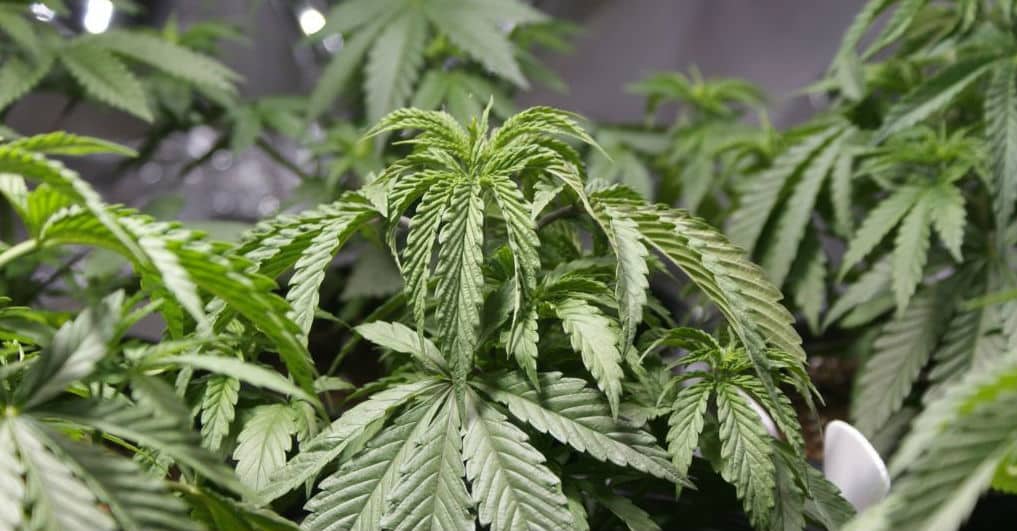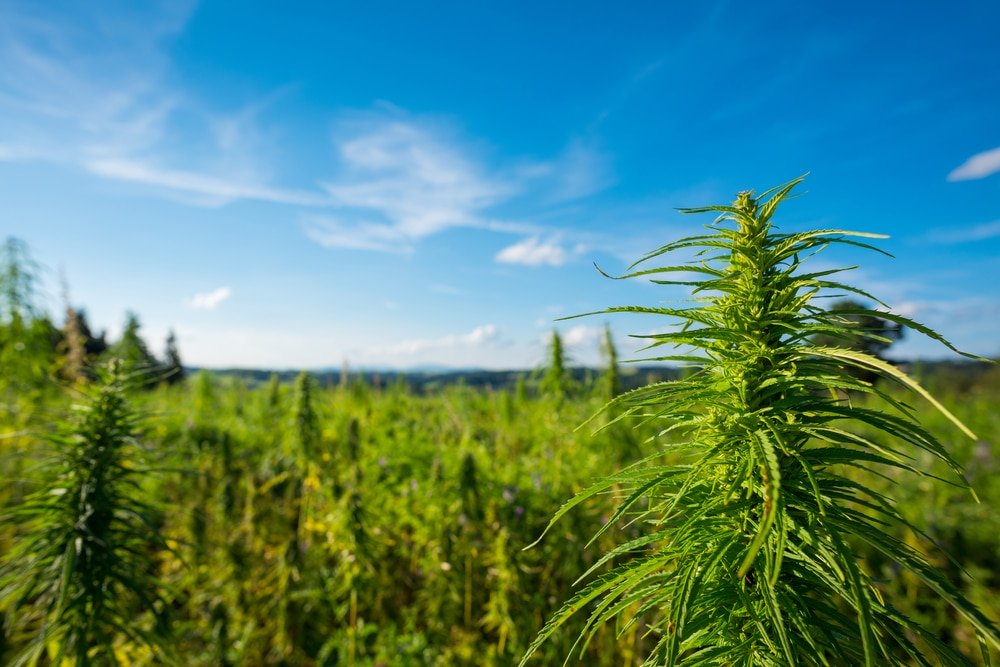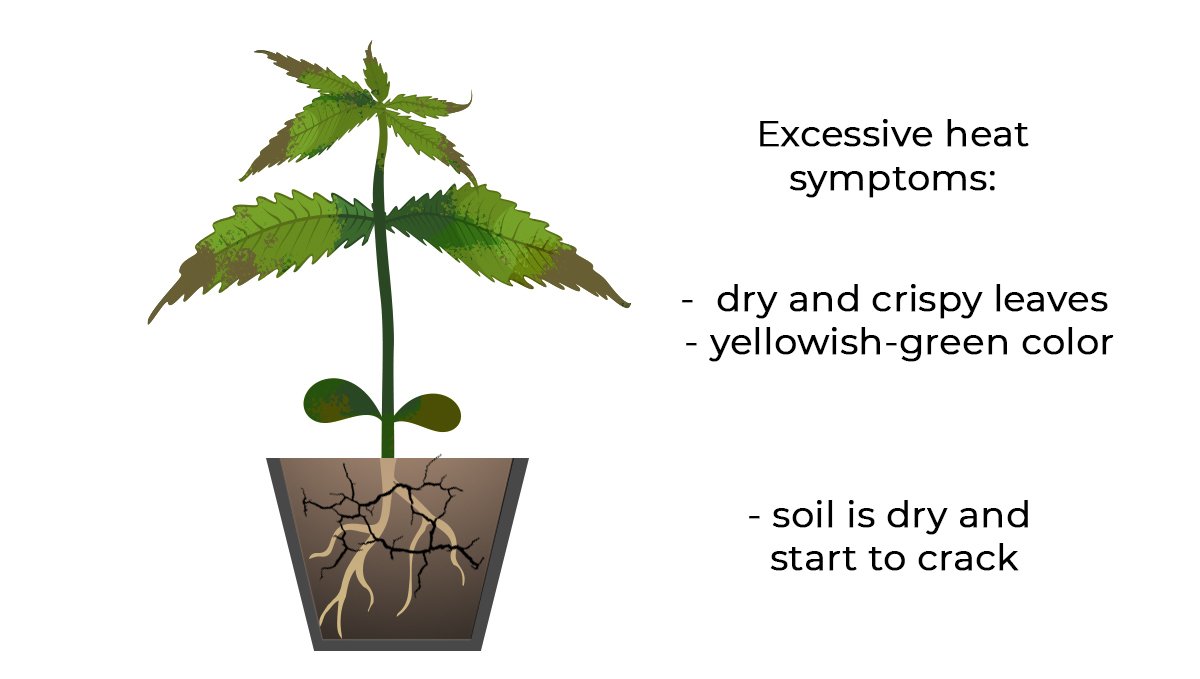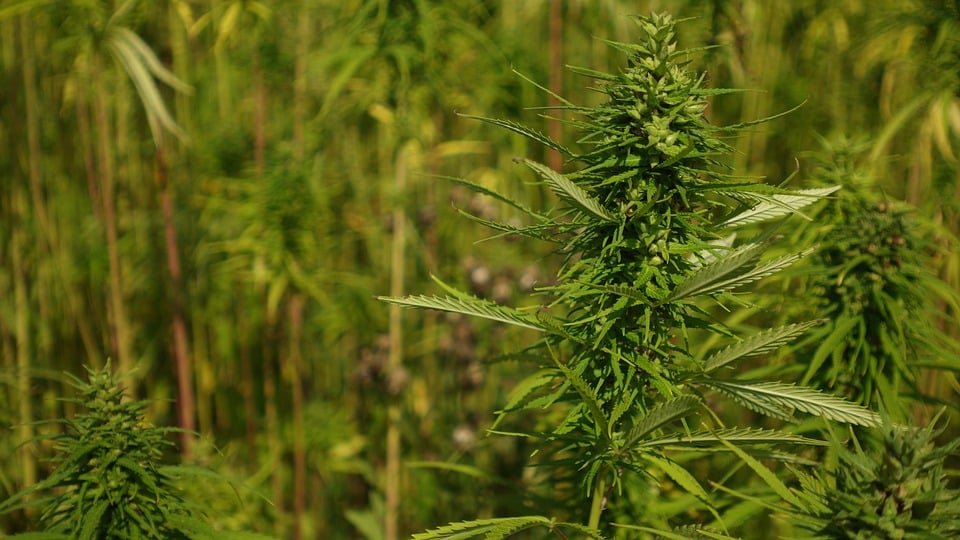No products in the cart.
Marijuana Education
Troubleshooting Drooping Cannabis Leaves
Wilted or drooping cannabis leaves have a depressing appearance and may cause you to panic. Don’t fear; many growers experience it, and plenty of solutions exist to fix the issue.
These problems can occur on a healthy plant for various reasons, but they typically indicate under or over-watering.
Paying attention to your crops, understanding their needs, and immediately addressing issues can help them return to full health.
Read on to learn about drooping leaves and how to treat an affected cannabis plant.
Why do cannabis leaves droop?
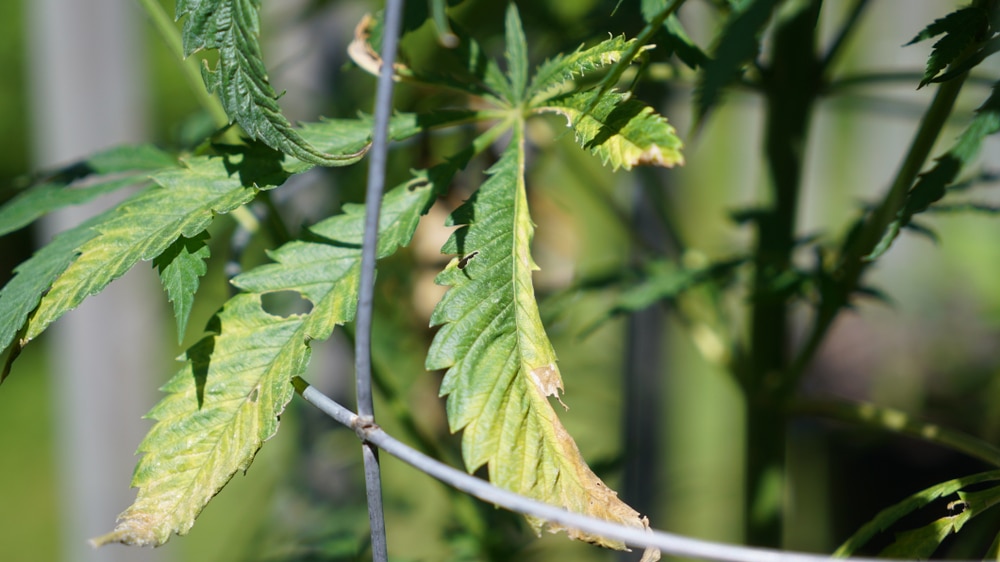
Drooping cannabis leaves usually indicate a watering problem. It’s simple to fix if you act quickly.
Water makes up 90–95% of a healthy marijuana plant and is essential for growth and survival. It aids in controlling the crop’s temperature and serves as a carrier for vital nutrients.
Cannabis leaves wilting may indicate that your flowers aren’t getting enough water. A lack of moisture can inhibit many plant processes and cause several problems, including:
- It lowers the plant’s rate of photosynthesis, slowing growth and stunting healthy development.
- It forces the plant to respire faster, devoting valuable energy to breathing rather than growing.
- It can cause nutrient deficiencies because the plant cells can’t receive sufficient minerals via their usual water transport system. The leaves begin to turn yellow and may develop brown spots.
- It can negatively affect the final yield, causing buds not to develop fully. They’ll be less potent, with fewer terpenes and weaker flavors.
- It can cause the entire plant to shrivel up and become brittle. Completely dry roots can result in death, meaning lost yields.
Drooping leaves can also result from a drainage problem with your growing medium. Plant roots may be unable to breathe because of excess moisture that accumulates around them. They gradually deteriorate, become more vulnerable to rot, and may ultimately die.
A nutritional shortage can also cause cannabis leaves to droop and become unable to support their own weight. They start lifelessly sagging as they’re not strong enough to hold themselves up.
A healthy cannabis plant may have partly droopy leaves at any point during its life cycle. In fact, it can happen overnight when the plant needs to store energy and starts bending slightly.
If you see this, don’t panic; your crop will likely display full vigor again in the morning.
Another common time you may see drooping fanning leaves is when the plant is flowering, but this is only an issue if it becomes excessive. It occurs when nutrients flow between the buds, but it shouldn’t cause the entire structure to sag.
Watering and drooping marijuana leaves
A cannabis plant’s roots require consistent soil moisture for transpiration, where the leaves are constantly losing water.
At this point, the root system pulls water in and supplies it to the rest of the plant. Leaves start drooping if insufficient moisture hinders transpiration, affecting other vital functions.
If the roots become bone dry, shoots may start dying, and nutrient deficiency problems could occur.
Cannabis leaves start wilting if you don’t provide a crucial combination of nutrients and hydration. Too much water leads to various crop health difficulties, especially as it inhibits your plant from taking in more oxygen.
Maintaining the best watering practices for marijuana plants is essential for them to thrive and produce high-quality buds.
Overwatering cannabis plants
New growers may be concerned their plant isn’t receiving enough water when they notice sagging leaves. They might start hydrating their crops daily in an attempt to restore them.
This solution may be counterproductive, as more watering doesn’t necessarily cause the problem. Excessive and too-frequent hydrating can lead to issues.
Your marijuana crops can’t breathe if you overwater them, and it can cause droopy leaves. It prevents the roots from receiving enough oxygen, making them weak and soft.
If the overwatered plants receive excess moisture for too long, the leaves and buds may start rotting. They become more vulnerable to pests and may eventually perish.
Here are a few indicators that your marijuana plants are receiving too much water:
- Heavy, firm, and excessive foliage
- Droopy leaves
- A constantly wet growing medium
Underwatering cannabis plants
Growers may not water their plants enough for several reasons. Some people neglect to feed their plants properly, while others leave them outside to fend for themselves.
Not providing adequate water may result in wilting cannabis plant leaves. Vital plant processes cease to function properly, the rate of photosynthesis slows down, and growth is stunted.
Lack of water prevents your plants from absorbing nutrients, which can disrupt the pH balance and cause nutritional deficiencies.
In reaction to dry conditions, crops begin breathing more rapidly, causing them to expend vital energy and lose strength.
Here are a few warning signs of underwatering to watch out for:
- Cannabis leaves wilting
- Plants shriveling up
- Foliage becoming paler and turning yellow
- Leaves parching, curling up, and falling off
How do nutrients relate to drooping cannabis leaves?
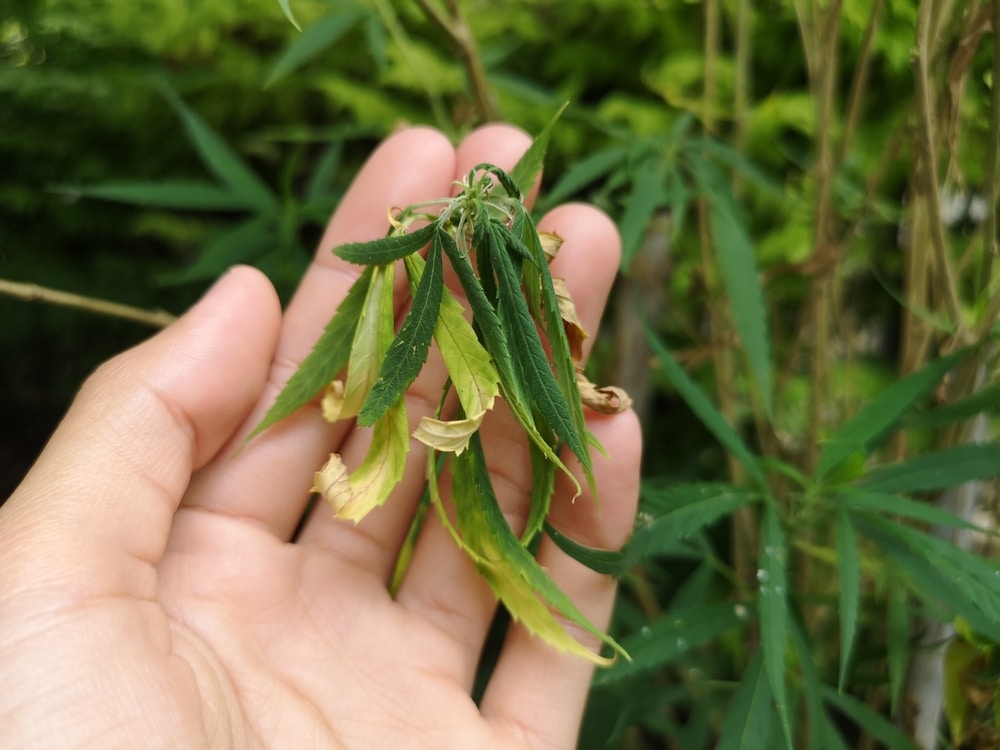
Drooping marijuana leaves could also mean your crops suffer from excess or insufficient nutrients. Problems like calcium, potassium, or magnesium deficiency have completely opposite causes but may display the same issues.
Diagnosing a nutrient deficiency vs. droopy cannabis leaves may complicate matters, but the symptoms are usually water-related.
Your plant’s roots can only breathe and absorb crucial minerals if you maintain proper moisture levels.
Inexperienced cannabis growers might think that drooping marijuana leaves require more fertilizer, but this isn’t always true. The abrupt influx of minerals can shock the plant and might result in problems like nutrient burn.
Following the correct feeding schedule prevents most issues, but a nutrient deficiency might still happen. Symptoms usually include yellowing leaves and brown spots across the top and bottom surfaces.
Lack of calcium is another possible mineral shortage that can lead to sagging.
Wet climates are more susceptible to this problem, which can cause the roots to deteriorate and eventually die.
Take immediate action if you notice any wilted marijuana leaves with yellow patches.
Purchase marijuana plant-specific nutrient solutions to prevent problems. These products typically have the correct amounts for cannabis seedlings and vegetating and flowering crops.
Drooping marijuana leaves can be biological and normal
Cannabis leaves can droop naturally, too. It’s not unusual to see their vigor wane at night or after turning off the lights in your grow room.
Weed plants droop at this time of day to conserve as much energy as possible.
Another common occurrence in cannabis plants is foliar nyctinasty, or nastic movement. This behavior presents as horizontal leaves during the day for optimal photosynthesis, but at night they tend to bend and grow vertically.
Another natural reason why leaves droop at night is to reduce heat loss.
It also causes excess water to run off the leaves rather than becoming saturated, preventing mildew and mold from forming.
Sagging leaves may also be a natural defense mechanism for plants, making them appear less desirable for insects or animals to eat.
For these reasons, don’t worry if you notice droopy cannabis leaves at night. It may only be necessary to take action if you see them in the daytime.
How to fix a drooping plant?
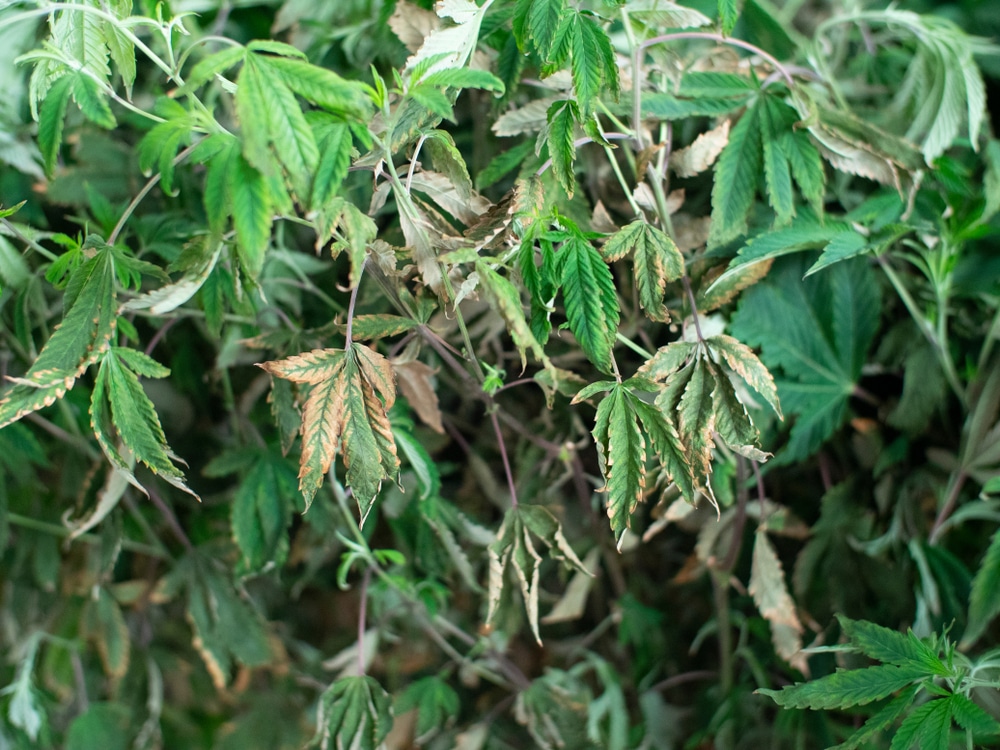
Wilting or drooping leaves usually indicate that your plant lacks something.
Deficiencies can originate in several places, and drooping leaves may mean you’ve given your plant too little or too much water.
They may also indicate that your plant is receiving excess or insufficient nutrients.
A growing medium with sufficient drainage can help you solve many common problems. You can determine moisture levels using your fingers or monitoring a pot’s weight.
A more precise way to measure them is to purchase a soil sensor, eliminating the guesswork for you.
Choosing the perfect time to water your plants is also vital in preventing drooping leaves. The morning is usually the best.
Remember to poke holes in the bottom of your container to promote sufficient drainage.
Start with a smaller growing medium at the beginning of cultivation so that the potting mix has less water to get rid of. Doing this hydrates your plants more because they’re draining correctly and getting enough oxygen.
Transplant your plant into a bigger container once it starts growing rapidly.
Follow these tips to help a drooping plant:
- Fill the growing medium with water, saturating it until about 20% drips out the bottom, indicating adequate hydration for the day.
- Wait until the first inch is dry before watering again.
- If you notice your cannabis plants wilting, aerate the medium by poking holes into it with a stick after allowing it to dry completely. Avoid damaging the roots at all costs.
- Make tiny holes, roughly two inches deep, by poking a thin stick around the medium’s edges.
- Use another stick for support, placing it near the base of the plant or tying it to the main stem.
- Ensure your plant receives at least 18 hours of sunlight daily by placing it underneath the lighting source.
- If it’s cold, your plants lose water less frequently as their functions slow down during cooler temperatures. It isn’t a cause for concern; it only means the crop won’t require as much hydration.
- You may lose a few weeks of progress if your plants have drooping leaves early in the growth cycle. Wait a little longer to start flowering, and you’ll still get strong, healthy plants that produce a substantial harvest.
Solutions for drooping cannabis leaves
Your plants may start drooping for several reasons, but there are simple solutions that can fix it. Setting up an ideal growing environment is vital for preventing a host of issues.
Below are a few tips and solutions that help promote vigorous, healthy cannabis plants.
Invest in a growing medium with good drainage
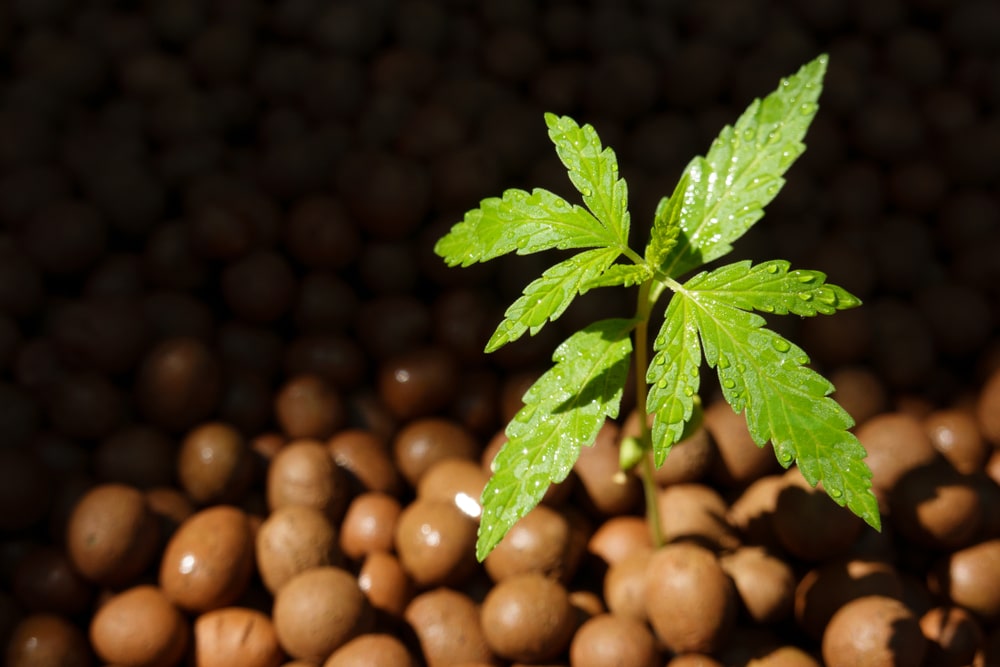
Choosing the correct growing medium is an essential step in cannabis cultivation. It’s vital to purchase one with adequate drainage to prevent issues.
If water doesn’t drain correctly at the container’s bottom, it can collect by the roots and stagnate, causing a build-up.
Try to avoid clay-based soil as it retains excessive amounts of moisture. Instead, invest in high-quality fertilizers or potting mix that contains perlite for superior drainage.
Start with a smaller container to lessen the chance of over-watering your plants. Ensure it has enough drainage holes that enable water to run out the bottom.
Add perlite if you discover poor drainage and want to boost it. The product also improves airflow and increases oxygen levels, promoting better crop health.
Keep the plant from sitting in a container that has accumulated runoff water accumulated. Check the plant’s tray frequently and empty it if necessary. Soil that doesn’t drain well will look like mud if you over-water it.
Using your fingers and knuckles method
One of the most crucial skills to acquire in cannabis cultivation is properly hydrating your plants.
Give them more space between watering if their leaves are drooping and showing signs of excessive hydration.
You can tell if your plants need extra water by sticking two fingers, or knuckles, an inch into the soil.
The top inch should ideally be dry before you resupply moisture, but you should wait a little longer if it’s still wet.
One sign of too much water is soggy soil. If you notice this, let a few days pass to allow the medium to dry properly.
When the top inch is dry and needs more moisture, keep providing water until about 20% extra liquid starts dripping out of the bottom of the medium.
In ideal circumstances, you should water your plants every second or third day. If the top inch of soil remains moist for longer, it indicates you should supply less water or improve the drainage system.
Lift-the-pot technique
Picking up the pot is a simple technique to determine whether the plant is thirsty.
Crops usually consume all the water in their containers, causing them to get lighter gradually.
You can purchase an additional container and fill it with the same growing medium if you need something to compare it to.
The new container reflects the “dry weight” of the growing medium. When a potted plant weighs the same or only a little more than its dry pot, it needs watering.
Change the drainage system if the growing medium stays wet for four days or longer. Growing little plants in too-big containers can also cause water absorption and draining issues.
Soil sensor

A soil sensor is another fantastic method for determining how dry your medium is. The gadget is widely available in gardening supply stores or online shops and typically costs about $10–20.
Soil sensors provide accurate measurements and eliminate the guesswork in checking moisture levels. You only need to stick it into the earth to get a reading.
There are two main types of soil sensors for assessing moisture.
You measure the soil’s water volume with volumetric sensors, while tensiometers evaluate the potential moisture levels.
A tensiometer is sensitive to the characteristics of the soil, and it measures how tightly a specific type of earth retains water.
A time domain reflectometer (TDR) is another swift, reliable way to measure soil moisture, but it may be expensive and frequently requires calibration. It also relies on a certain level of expertise to correctly understand the data.
Your best option may be a basic soil sensor, as it’s affordable, efficient, and simple to use. It might enable you to spot a problem with your soil before it worsens.
Choose a “dry” strain
Specific strains could be beneficial to avoiding issues if you’re in hotter regions. Some cultivars from Mexico, Colombia, and Jamaica do particularly well in warmer climates. They’re also ideal for growers who are unable to give their plants enough water.
Search for varieties like Blue Dream and Green Crack, which have reputations for being relatively simple to grow.
They require less water than many commercial strains, require minimal upkeep, and you can leave them alone for extended periods.
Differentiate between drooping and wilting leaves
When your leaves begin to curl at the tips and start yellowing, appearing dead or worn out, this is known as wilting. If you leave lower foliage untreated for too long, they die and drop off. This issue usually occurs from under-watering.
Drooping is differentiated by the entire leaves sagging, as opposed to simply the tips. You won’t notice yellow ends on the leaves, and they stay firm and green. This issue is usually because of over-watering.
How frequently should I water my marijuana plants?
Cannabis plants have different requirements at each growth stage, from seed to harvest. They need a varied water content depending on how old they are.
Below is a summary of their needs as seedlings and as adults.
Seedlings
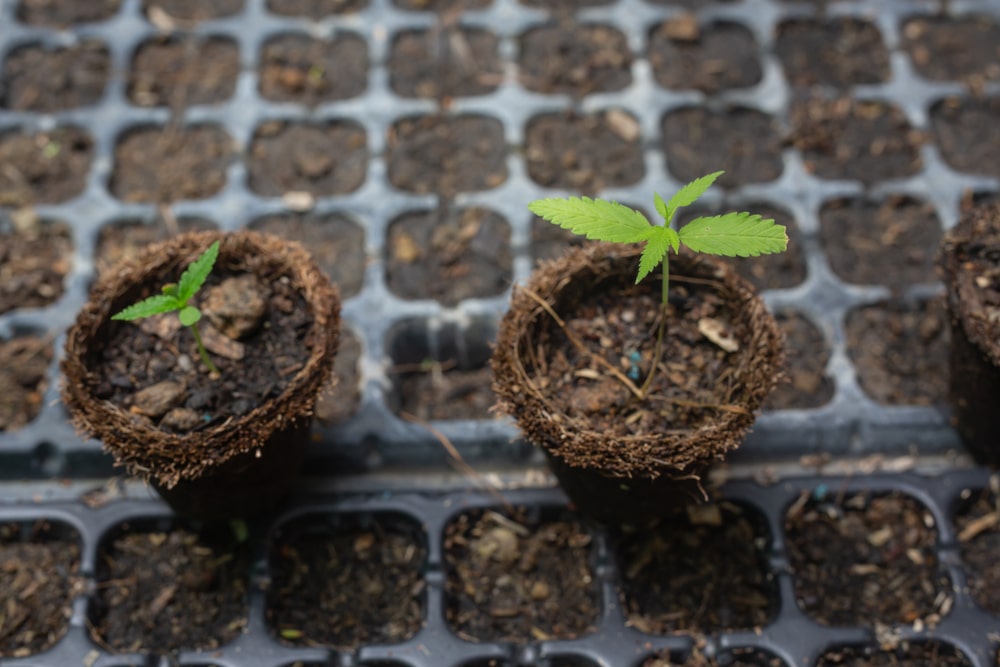
Seedlings (when sprouting around six sets of leaves) have different requirements depending on the size of the container they grow in.
If using a smaller container or solo cup, water the plant until you see runoff from the drainage holes. Wait until the surface is dry again before the next watering. Once they develop a couple of sets of leaves, you should move the seedlings to a larger pot.
When the second or third set of leaves appears, seedlings in a bigger pot usually overtake their siblings in smaller containers. You may keep plants in cups for as long as you want if you’re not in a rush. Many enjoy growing cannabis plants from seed to harvest in solo cups.
If using a bigger plant pot above one gallon, water the seedlings sparingly to allow the plant to stretch into its environment. Instead of supplying moisture to the entire container, pour it in a little circle at the plant’s base. It doesn’t need more hydration than that.
Adult cannabis plants
Once your plant displays rapid growth, you can supply it with more water.
Provide moisture when the first inch of the growing medium is dry. Remember to use a knuckle or finger to determine if watering is necessary.
If the soil dries out in a day or less, progressively provide more water until the moisture content stabilizes.
Pour slightly less water in if the soil takes over three days to dry.
Poor growth, fungus gnats, algae, and inadequate nutrition levels can all result from improper irrigation of plants.
No more droopy cannabis leaves
Seeing your cannabis plant in trouble is unsettling, especially as harvest time approaches. Luckily, fixing the problem and preventing it in the future is straightforward.
When you notice leaves drooping, re-evaluate your watering schedule and inspect the drainage in your growing medium.
Identifying and maintaining the ideal oxygen-to-water ratio in your soil is the key to growing healthy cannabis. Invest in a soil sensor to get precise pH and moisture readings.
You won’t need to worry about marijuana leaves drooping again after establishing the right balance.
For more information about how to deal with various cannabis growing issues, visit The Seed Fair. You also get access to the best seeds to guarantee optimal growth.
Many of our top-quality seeds are resistant to pests, mold, and diseases, ensuring an enjoyable cultivation experience and abundant harvests.


